"Non ducor duco."
Hi and welcome to my website, I hope you enjoy your visit, I hope to add loads of stuff as I go on. I will be adding loads more in the coming weeks/months/years so keep checking.
At the moment I have a sections on the History of Wrexham, Buildings and Places of Wrexham Past and Present, Villages and Places around Wrexham, Broughton Community, The Moss Valley and Gatewen Hall.
Please feel free to email me here with any questions, advice or photos you would like to add.
The above photo of my families bus company called Guy's buses.
At the moment I have a sections on the History of Wrexham, Buildings and Places of Wrexham Past and Present, Villages and Places around Wrexham, Broughton Community, The Moss Valley and Gatewen Hall.
Please feel free to email me here with any questions, advice or photos you would like to add.
The above photo of my families bus company called Guy's buses.
Buildings and Places of Wrexham Past and Present
Looking at the skyline of Wrexham there are a few notable buildings we can see, St Giles Church
(The Parish Church) ,Wrexham Swimming Baths (Wrexham Waterworld) ,The Racecourse (home of Wrexham Football Club) and Wrexham Police Station.
There are also some not so noticable and some that are long gone or vastly changed.
(The Parish Church) ,Wrexham Swimming Baths (Wrexham Waterworld) ,The Racecourse (home of Wrexham Football Club) and Wrexham Police Station.
There are also some not so noticable and some that are long gone or vastly changed.
St Giles Church (The Parish Church)
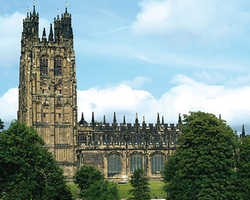
The Parish Church of St.Giles is surely Wrexham's greatest landmark. Described in the 19th Century as one of the Seven Wonders of Wales, it is commemorated in an anonymously written rhyme:
Pistyll Rhaeadr and Wrexham steeple,
Snowdon's mountain without its people,
Overton yew trees, St Winefride wells,
Llangollen bridge and Gresford bells.
The church is the historic centre of the town.
The street pattern reveals how the town grew out from the boundary of the churchyard, which is typical of medieval towns across Britain.
It can be seen for many miles around as the tallest building in the town, but in fact it turns out to be not a steeple at all, but the 16th century tower of the Church of St. Giles. Wrexham had a church in the 13th Century as both the Bishop of St Asaph and Madog ap Gruffudd, Prince of Powys gave income from the church to the monks at Valle Crucis, near Llangollen.
In 1330 the tower collapsed, tradition has it that the locals feared that God had punished them for having Sunday as their market day. They decided it might be better to have their market on Thursdays from then on.
Despite these precautions, in 1463 fire struck and much of the church was destroyed. Between 1463 -1520 the church was rebuilt perhaps with the help of a patron, Lady Margaret Beaufort: the result a church that represents the culmination of the medieval and Catholic church design.
It records the final flowering of religious belief before the bloodletting and intellectual struggles of the Reformation.
St Giles' is a must for any visitor to the town. Though Oliver Cromwell used the church as stabling for his army's horses, others have appreciated its beauty. Both William Morris and Sir Giles Gilbert Scott stepped into the fray to save the church from the plans of well-intentioned clergymen in the 19th Century.
The richly-decorated tower, 135-feet high, with its four striking hexagonal turrets, was begun in 1506. It is graced by many medieval carvings including those of an arrow and a deer, the attributes of Saint Giles. The interior of the church also contains many late medieval carvings and monuments. On a window you can find the words of the Evangelical hymn "From Greenland's Icy Mountains." which was written by Reginald Heber and first performed at the Church in 1819. Just west of the tower is the grave of Elihu Yale, after whom Yale University in the USA is named, with its long, fanciful epitaph containing the following lines:
Born in America,
in Europe bred,
In Africa travell'd, and in Asia wed,
Where long he lov'd and thriv'd;
At London dead.
The churchyard is entered through wrought-iron gates, completed in 1719 by the Davies Brothers of nearby Bersham. They who were also responsible for the gates of Chirk Castle, perhaps the finest example of wrought-iron work in Britain, and the gates at Sandringham House, one of the English monarch's residences, and at Leeswood Hall, near Mold in Flintshire.
The church is a place of worship but it is a welcoming place and there are regular tours up the tower especially during the autumn Heritage Open Days.
Pistyll Rhaeadr and Wrexham steeple,
Snowdon's mountain without its people,
Overton yew trees, St Winefride wells,
Llangollen bridge and Gresford bells.
The church is the historic centre of the town.
The street pattern reveals how the town grew out from the boundary of the churchyard, which is typical of medieval towns across Britain.
It can be seen for many miles around as the tallest building in the town, but in fact it turns out to be not a steeple at all, but the 16th century tower of the Church of St. Giles. Wrexham had a church in the 13th Century as both the Bishop of St Asaph and Madog ap Gruffudd, Prince of Powys gave income from the church to the monks at Valle Crucis, near Llangollen.
In 1330 the tower collapsed, tradition has it that the locals feared that God had punished them for having Sunday as their market day. They decided it might be better to have their market on Thursdays from then on.
Despite these precautions, in 1463 fire struck and much of the church was destroyed. Between 1463 -1520 the church was rebuilt perhaps with the help of a patron, Lady Margaret Beaufort: the result a church that represents the culmination of the medieval and Catholic church design.
It records the final flowering of religious belief before the bloodletting and intellectual struggles of the Reformation.
St Giles' is a must for any visitor to the town. Though Oliver Cromwell used the church as stabling for his army's horses, others have appreciated its beauty. Both William Morris and Sir Giles Gilbert Scott stepped into the fray to save the church from the plans of well-intentioned clergymen in the 19th Century.
The richly-decorated tower, 135-feet high, with its four striking hexagonal turrets, was begun in 1506. It is graced by many medieval carvings including those of an arrow and a deer, the attributes of Saint Giles. The interior of the church also contains many late medieval carvings and monuments. On a window you can find the words of the Evangelical hymn "From Greenland's Icy Mountains." which was written by Reginald Heber and first performed at the Church in 1819. Just west of the tower is the grave of Elihu Yale, after whom Yale University in the USA is named, with its long, fanciful epitaph containing the following lines:
Born in America,
in Europe bred,
In Africa travell'd, and in Asia wed,
Where long he lov'd and thriv'd;
At London dead.
The churchyard is entered through wrought-iron gates, completed in 1719 by the Davies Brothers of nearby Bersham. They who were also responsible for the gates of Chirk Castle, perhaps the finest example of wrought-iron work in Britain, and the gates at Sandringham House, one of the English monarch's residences, and at Leeswood Hall, near Mold in Flintshire.
The church is a place of worship but it is a welcoming place and there are regular tours up the tower especially during the autumn Heritage Open Days.
Wristlesham Motte and Bailey Castle
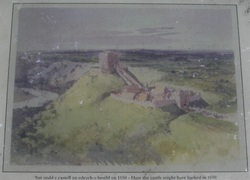
Wrexham is not mentioned in the Domesday Book, the first mention of it comes in 1161 by which time there was a Norman motte and bailey castle at 'Wristlesham', located in what is now 'Erddig Park, however, being well to the east of Offa's Dyke, there has probably been a settlement there since Saxon times.
The castle was built by 'Hugh the Fat', who brought his Norman troops over the Welsh border from Chester to erect the castle, a similar edifice being constructed at Hodeslea(later Hoseley, now Marford.)
King Edward 1st is on record as having briefly stayed at Wrexham during his expedition to suppress the revolt of Madoc Ap Llewellyn in 1294.
The castle was built by 'Hugh the Fat', who brought his Norman troops over the Welsh border from Chester to erect the castle, a similar edifice being constructed at Hodeslea(later Hoseley, now Marford.)
King Edward 1st is on record as having briefly stayed at Wrexham during his expedition to suppress the revolt of Madoc Ap Llewellyn in 1294.
R.A.F Wrexham
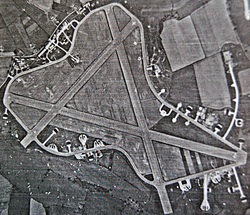
RAF Wrexham was a World War II Royal Air Force airfield at Borras, near Wrexham.
The first noted involvement of aviation with Wrexham was in 1912 when Gustav Hamel visited the Racecourse Ground to entertain the public with air displays. The local council discussed transforming the racecourse into a municipal airport.
During the period 1917 - 1920 fields at Borras Lodge were used by Nos. 4 and 51 Training Squadrons/Schools of the Royal Flying Corps / Royal Air Forcebased at Shotwick (later RAF Sealand) and Hooton Park. The same location was also used by the Lancashire Aero Club and the Liverpool and District Aero Club for air displays during the 1930s, and two visits from Sir Alan Cobham's National Aviation day Circus.
The Air Ministry bought up land in Borras from the Gredington estate,taking fields from Borras Lodge, Borras Head, Borras Hall, Gourton Hall,Plas Goulbourne and Wrexham Golf Club in the early days of the Second World War.
As the entire area was on a plateau, the field was largely dry, unlike RAF Sealand and Hawarden Airport, both reclaimed from the River Dee. This dryness encouraged visits from several training squadrons, such as spitfires from RAF Ternhill. After the initial breakout of the War, No 5 Service Flying Training School used the ground as a relief strip, and in 1940, three grass runways of approximately 550-660 yards existed. The wet conditions of surrounding airfields usually caused training groups to send planes to Wrexham, which had no air traffic control, which caused several incidents.
The main period of construction at the site took place between December 1940 and June 1941, which often saw floodlit operations during the dark winter.
The airfield was upgraded with hardened concrete runways and appropriate lighting for them,with defence against any possible ground invasion provided by the ring of defences surrounding the nearby Royal Ordnance Factory.
The Airfield was primarily built to house a night fighter squadron for the air defence of Liverpool and Manchester, and in 1941, No. 96 Squadron RAF, a night fighter squadron, was moved to Wrexham from RAF Cranage. In 1944 it was occupied by RAF. 21 Grp. AFU.
It was also home to No. 285 Squadron, which provided Target tug aircraft for training exercises, starting with Bristol Blenheims, Lockheed Hudsons and Westland Lysanders, later replaced with Boulton Paul Defiants and Miles Martinets. After moving through a number of Headquarters, this squadron was disbanded 26 June 1945.
The airfield was closed in 1945 and on 22 October 1959, it was sold to United Gravel Company a subsidiary of Alfred McAlpine. In the 1970's quarrying operations commenced in the area and have almost completely obliterated the site. As recently as 2004, the original runway surface and paint still existed in places.
The site is also referred to as Borras Airfield. In 1977 the National Eisteddfod of Wales was held on the airfield.
In 2005, the Tarmac quarry posted an application to increase quarrying activities. As a result of the archaeological report of this application, several of the original structures have been deemed intact, including a Bellman hangar, several gunnery butts, which were brick buildings used for target practice and alignment of fighter weapons.
There are also several air crash sites in the area, including a Bristol Beaufighter that crashed into a pond.
There was a US Army cubstrip on the Aerodrome itself. This was a small designated area where US Army Piper Cubs could land, in support of the 400th Armored Field Artillery battalion and No 33 Signals Construction Battalion, who were billeted in local houses, most notably Acton Hall. There were no surface treatment or buildings at any of these sites. As well as the one on the airfield, there were four others; two in Acton, one just outside the Airfield, and one in Gresford, opposite the entrance gates of Gresford Colliery. These were used by the 322nd Field Artillery Battalion of the 83rd Infantry Division. None of these sites lasted more than a year.
At the end of the war RAF Wrexham became a base for packing spare parts for shipment overseas before being down-graded to 'care and maintenance'.In it's latter years as an airfield, Borras as it is locally known was the home to Sir Jimmy McAlpine's Beech Super King Air until the final runway was dug up in the quest for gravel.
The first noted involvement of aviation with Wrexham was in 1912 when Gustav Hamel visited the Racecourse Ground to entertain the public with air displays. The local council discussed transforming the racecourse into a municipal airport.
During the period 1917 - 1920 fields at Borras Lodge were used by Nos. 4 and 51 Training Squadrons/Schools of the Royal Flying Corps / Royal Air Forcebased at Shotwick (later RAF Sealand) and Hooton Park. The same location was also used by the Lancashire Aero Club and the Liverpool and District Aero Club for air displays during the 1930s, and two visits from Sir Alan Cobham's National Aviation day Circus.
The Air Ministry bought up land in Borras from the Gredington estate,taking fields from Borras Lodge, Borras Head, Borras Hall, Gourton Hall,Plas Goulbourne and Wrexham Golf Club in the early days of the Second World War.
As the entire area was on a plateau, the field was largely dry, unlike RAF Sealand and Hawarden Airport, both reclaimed from the River Dee. This dryness encouraged visits from several training squadrons, such as spitfires from RAF Ternhill. After the initial breakout of the War, No 5 Service Flying Training School used the ground as a relief strip, and in 1940, three grass runways of approximately 550-660 yards existed. The wet conditions of surrounding airfields usually caused training groups to send planes to Wrexham, which had no air traffic control, which caused several incidents.
The main period of construction at the site took place between December 1940 and June 1941, which often saw floodlit operations during the dark winter.
The airfield was upgraded with hardened concrete runways and appropriate lighting for them,with defence against any possible ground invasion provided by the ring of defences surrounding the nearby Royal Ordnance Factory.
The Airfield was primarily built to house a night fighter squadron for the air defence of Liverpool and Manchester, and in 1941, No. 96 Squadron RAF, a night fighter squadron, was moved to Wrexham from RAF Cranage. In 1944 it was occupied by RAF. 21 Grp. AFU.
It was also home to No. 285 Squadron, which provided Target tug aircraft for training exercises, starting with Bristol Blenheims, Lockheed Hudsons and Westland Lysanders, later replaced with Boulton Paul Defiants and Miles Martinets. After moving through a number of Headquarters, this squadron was disbanded 26 June 1945.
The airfield was closed in 1945 and on 22 October 1959, it was sold to United Gravel Company a subsidiary of Alfred McAlpine. In the 1970's quarrying operations commenced in the area and have almost completely obliterated the site. As recently as 2004, the original runway surface and paint still existed in places.
The site is also referred to as Borras Airfield. In 1977 the National Eisteddfod of Wales was held on the airfield.
In 2005, the Tarmac quarry posted an application to increase quarrying activities. As a result of the archaeological report of this application, several of the original structures have been deemed intact, including a Bellman hangar, several gunnery butts, which were brick buildings used for target practice and alignment of fighter weapons.
There are also several air crash sites in the area, including a Bristol Beaufighter that crashed into a pond.
There was a US Army cubstrip on the Aerodrome itself. This was a small designated area where US Army Piper Cubs could land, in support of the 400th Armored Field Artillery battalion and No 33 Signals Construction Battalion, who were billeted in local houses, most notably Acton Hall. There were no surface treatment or buildings at any of these sites. As well as the one on the airfield, there were four others; two in Acton, one just outside the Airfield, and one in Gresford, opposite the entrance gates of Gresford Colliery. These were used by the 322nd Field Artillery Battalion of the 83rd Infantry Division. None of these sites lasted more than a year.
At the end of the war RAF Wrexham became a base for packing spare parts for shipment overseas before being down-graded to 'care and maintenance'.In it's latter years as an airfield, Borras as it is locally known was the home to Sir Jimmy McAlpine's Beech Super King Air until the final runway was dug up in the quest for gravel.
Abbotsfield
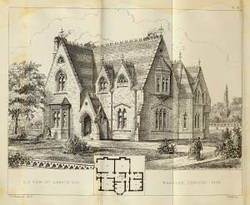
Abbotsfield on Grosvenor Road was designed in the 1860's as a private residence by the Wrexham architect J.R. Gummow.
Abbotsfield was the first house to be built at the Rhosddu end of Grosvenor Road.
In 1895 it became the home of local surgeon John Arthur Eyton-Jones,MD. It later became the Area Education Office under the council before being sold during the 1970's when it became a hotel. It is now 'The Lemon Tree' Italian restaurant bar and hotel.
Abbotsfield was the first house to be built at the Rhosddu end of Grosvenor Road.
In 1895 it became the home of local surgeon John Arthur Eyton-Jones,MD. It later became the Area Education Office under the council before being sold during the 1970's when it became a hotel. It is now 'The Lemon Tree' Italian restaurant bar and hotel.
Acton Hall

The Jeffreys, a Welsh family, lived at Acton Hall in the 17th century. The family motto was 'Pob dawn o Dduw' - Every gift from God.
The most famous member of the family being the notorious 'Hanging Judge Jeffreys'.
George Jeffreys was born in 1647 at Acton. He went to school in Shrewsbury and later in London. He then trained in law where he spent much time drinking and networking. The latter would serve him well.
He led an eventful life and made many enemies. In 1680 he became Chief Justice of Chester, despite 'being the worst that ever disgraced the bench.'
Yet Charles II made him Lord Chief Justice of all England in 1683. Two years later, Jeffreys ensured his name would go down in history. He presided over the Bloody Assizes in 1685. Monmouth and his Protestant supporters had rebelled against James II and had lost. Jeffreys presided over the trials of the captured rebels. Nearly 300 were executed and hundreds shipped off as slaves to the West Indies. In folk history, Jeffreys revelled in his power and is said to have extorted money from the families of the accused as they asked for mercy.
Jeffreys had nailed his colours to the mast of James II. That was a big mistake. In 1688 William of Orange and his allies in England staged a coup and toppled James from the throne. Jeffreys tried to flee abroad disguised as a sailor. He was caught in a pub with 35,000 guineas and a load of silver ware. Barely surviving the mob, he was imprisoned in the Tower of London and died there in 1689. His enemies wrote the history books and Jeffreys' reputation was ruined for ever more.
Sir Griffith Jeffreys rebuilt the family home between 1687 - 1695 and enlarged in 1786-7. The park was created in the 1790s. Sir Griffith Jeffreys wife Dame Dorothy set up a charity in her will which helped found many of the first schools in Wrexham.
After the Jeffreys the house belonged to Philip Egerton and then Ellis Yonge before being purchased by Sir Foster Cunliffe for £27,000.
Sir Foster repaired the property and added a new wing. The house at this time was redbrick with stone quoins. In the 1790s Sir Foster created a landscaped park with garden and lake, all enclosed inside a boundary wall. In 1820 he created a new entrance for the house on Chester Road with a neo-classical gateway.
Later generations did little to improve the property. The 4th Baronet stuccoed the walls of the house, while the 5th Baronet faced it with stone in such a way that the house seemed to be of three different styles - none matching the other.
In 1917 Acton Park was bought by Sir Bernard Oppenheimer. The Denbighshire Hussars were still billeted in the house and grounds. Oppenheimer opened a diamond cutting training school and workshop in the grounds of Acton Park. The scheme was designed to ensure jobs for ex-servicemen. It was the 'Homes Fit For Heroes' ethos in action, but Sir Bernard's untimely death in 1921 led to the workshop closing.
Nine Acre Field and sixty acres by Rhosnesni Lane were bought by the Borough Council. Patrick Abercrombie was commissioned to design a quality housing scheme for the sixty acres. Building started in 1921. The design of Abercrombie survives to this day. The rest of the estate was turned into small holdings for ex-soldiers. There were seven market garden and four dairy holdings.
William Aston purchased the house and grounds on the death of Sir Bernard. His initial plan to turn the hall into a technical school never took off. Instead the hall became a showroom and store for Aston's furniture company. The grounds were opened to the public.
In 1939 the War Office requisitioned Acton Park. Nissen huts were erected in the ground for the soldiers. The officers were billeted in the house. The Lancashire Fusiliers, the Royal Welch Fusiliers, the South Wales Borderers and the Gurkhas were just a few of the regiments who stayed at Acton during the Second World War.
In 1943 the 33rd Signals Construction Battalion and 400th Armoured Field Artillery Battalion were billeted at Acton Park. Wrexham was host to men from Kentucky, Ohio, West Virginia and Indiana. Eagles Meadow became their vehicle store, the Butter Market their canteen, Acton School Hall the venue for their dances and chewing gum was sold at the US Army store in Garden Village. The US Army was still segregated. Black soldiers were billeted at 'The Studio' by the junction of Chester Road and Grove Road.
The house just survived the US Army, but in a very poor state. The north wing was demolished just after the war. People plundered the park for firewood in the tough years of rationing in 1945-47. By 1954 the house was an eye sore. Alderman Hampson campaigned for the house to be saved as the town's museum. He failed and the demolition team set to work in August 1954.
Nothing now remains of the house. A new housing development along Herbert Jennings Avenue was built over much of the park, while the remainder was saved as a green space for the people of Wrexham.
The most famous member of the family being the notorious 'Hanging Judge Jeffreys'.
George Jeffreys was born in 1647 at Acton. He went to school in Shrewsbury and later in London. He then trained in law where he spent much time drinking and networking. The latter would serve him well.
He led an eventful life and made many enemies. In 1680 he became Chief Justice of Chester, despite 'being the worst that ever disgraced the bench.'
Yet Charles II made him Lord Chief Justice of all England in 1683. Two years later, Jeffreys ensured his name would go down in history. He presided over the Bloody Assizes in 1685. Monmouth and his Protestant supporters had rebelled against James II and had lost. Jeffreys presided over the trials of the captured rebels. Nearly 300 were executed and hundreds shipped off as slaves to the West Indies. In folk history, Jeffreys revelled in his power and is said to have extorted money from the families of the accused as they asked for mercy.
Jeffreys had nailed his colours to the mast of James II. That was a big mistake. In 1688 William of Orange and his allies in England staged a coup and toppled James from the throne. Jeffreys tried to flee abroad disguised as a sailor. He was caught in a pub with 35,000 guineas and a load of silver ware. Barely surviving the mob, he was imprisoned in the Tower of London and died there in 1689. His enemies wrote the history books and Jeffreys' reputation was ruined for ever more.
Sir Griffith Jeffreys rebuilt the family home between 1687 - 1695 and enlarged in 1786-7. The park was created in the 1790s. Sir Griffith Jeffreys wife Dame Dorothy set up a charity in her will which helped found many of the first schools in Wrexham.
After the Jeffreys the house belonged to Philip Egerton and then Ellis Yonge before being purchased by Sir Foster Cunliffe for £27,000.
Sir Foster repaired the property and added a new wing. The house at this time was redbrick with stone quoins. In the 1790s Sir Foster created a landscaped park with garden and lake, all enclosed inside a boundary wall. In 1820 he created a new entrance for the house on Chester Road with a neo-classical gateway.
Later generations did little to improve the property. The 4th Baronet stuccoed the walls of the house, while the 5th Baronet faced it with stone in such a way that the house seemed to be of three different styles - none matching the other.
In 1917 Acton Park was bought by Sir Bernard Oppenheimer. The Denbighshire Hussars were still billeted in the house and grounds. Oppenheimer opened a diamond cutting training school and workshop in the grounds of Acton Park. The scheme was designed to ensure jobs for ex-servicemen. It was the 'Homes Fit For Heroes' ethos in action, but Sir Bernard's untimely death in 1921 led to the workshop closing.
Nine Acre Field and sixty acres by Rhosnesni Lane were bought by the Borough Council. Patrick Abercrombie was commissioned to design a quality housing scheme for the sixty acres. Building started in 1921. The design of Abercrombie survives to this day. The rest of the estate was turned into small holdings for ex-soldiers. There were seven market garden and four dairy holdings.
William Aston purchased the house and grounds on the death of Sir Bernard. His initial plan to turn the hall into a technical school never took off. Instead the hall became a showroom and store for Aston's furniture company. The grounds were opened to the public.
In 1939 the War Office requisitioned Acton Park. Nissen huts were erected in the ground for the soldiers. The officers were billeted in the house. The Lancashire Fusiliers, the Royal Welch Fusiliers, the South Wales Borderers and the Gurkhas were just a few of the regiments who stayed at Acton during the Second World War.
In 1943 the 33rd Signals Construction Battalion and 400th Armoured Field Artillery Battalion were billeted at Acton Park. Wrexham was host to men from Kentucky, Ohio, West Virginia and Indiana. Eagles Meadow became their vehicle store, the Butter Market their canteen, Acton School Hall the venue for their dances and chewing gum was sold at the US Army store in Garden Village. The US Army was still segregated. Black soldiers were billeted at 'The Studio' by the junction of Chester Road and Grove Road.
The house just survived the US Army, but in a very poor state. The north wing was demolished just after the war. People plundered the park for firewood in the tough years of rationing in 1945-47. By 1954 the house was an eye sore. Alderman Hampson campaigned for the house to be saved as the town's museum. He failed and the demolition team set to work in August 1954.
Nothing now remains of the house. A new housing development along Herbert Jennings Avenue was built over much of the park, while the remainder was saved as a green space for the people of Wrexham.
Plas Coch /Plas Coch Retail Park
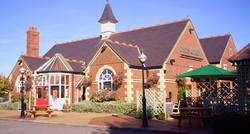
In 1670 a property called 'Plas Coch' meaning Red Hall appeared in the Hearth Tax Returns, it was an early brick gentry house that may have been built by Sir William Meredith of Stansty in about 1580/90. It was located almost exactly on the site of the present day Plas Coch Public House. It was later used as a farm (Plas Coch Farm)
The worlds first scheduled helicopter was inaugurated by British European Airways between Liverpool-Wrexham-Cardiff on June 2nd 1950 from Plas Coch.
Flights operated from a concrete pad on the site of the present day Homebase store. The company used a Westland Sikorsky S.51 Dragonfly helicopter. The only structure on the site was a pre-fabricated glass fronted cabin which served as a waiting room and seats could be booked through Denbighshire Travel.
Return flights to Cardiff cost £5 and Liverpool £1. The helicopters carried a maximum of three passengers, each carrying 33lbs of luggage and not surprisingly British European Airways did not find the service economically viable and the service was discontinued on March 31st 1951 by which time a total of 219 passengers had been carried.
In later years, Plas Coch formed part of the Clwyd County Council sports grounds on which were held various youth sports events including county athletics meetings and cricket matches. It was also used to hold the Wrexham Lager Festivals.
During the 1980's, Clwyd County Council sold the Plas Coch Fields and farmhouse for development as a retail park,
despite local opposition the house was demolished to make way for the public house which bears its name.
It is alleged that during the construction of the retail development in 1991, a hoard of Roman currency coins was discovered by workmen, however all of the coins disappeared. In 1995 further construction work on the site revealed traces of Roman field boundaries, hearths and a corn drying kiln. It is thought that these are the remains of a farmstead.
The first store to be built on the site was Sainsbury's which opened its doors on September 19th 1991 and is the largest store on the site, others include Aldi, Homebase, Boots the Chemist, Pets At Home, Sportsworld, Currys, Argos, Costa drive through and a DW fitness centre. The Plas Coch Public house has recently undergone an extension and refurbishment.
The worlds first scheduled helicopter was inaugurated by British European Airways between Liverpool-Wrexham-Cardiff on June 2nd 1950 from Plas Coch.
Flights operated from a concrete pad on the site of the present day Homebase store. The company used a Westland Sikorsky S.51 Dragonfly helicopter. The only structure on the site was a pre-fabricated glass fronted cabin which served as a waiting room and seats could be booked through Denbighshire Travel.
Return flights to Cardiff cost £5 and Liverpool £1. The helicopters carried a maximum of three passengers, each carrying 33lbs of luggage and not surprisingly British European Airways did not find the service economically viable and the service was discontinued on March 31st 1951 by which time a total of 219 passengers had been carried.
In later years, Plas Coch formed part of the Clwyd County Council sports grounds on which were held various youth sports events including county athletics meetings and cricket matches. It was also used to hold the Wrexham Lager Festivals.
During the 1980's, Clwyd County Council sold the Plas Coch Fields and farmhouse for development as a retail park,
despite local opposition the house was demolished to make way for the public house which bears its name.
It is alleged that during the construction of the retail development in 1991, a hoard of Roman currency coins was discovered by workmen, however all of the coins disappeared. In 1995 further construction work on the site revealed traces of Roman field boundaries, hearths and a corn drying kiln. It is thought that these are the remains of a farmstead.
The first store to be built on the site was Sainsbury's which opened its doors on September 19th 1991 and is the largest store on the site, others include Aldi, Homebase, Boots the Chemist, Pets At Home, Sportsworld, Currys, Argos, Costa drive through and a DW fitness centre. The Plas Coch Public house has recently undergone an extension and refurbishment.
The Racecourse Football Ground

Located on Mold Road, The Racecourse Ground (Welsh: Y Cae Ras) is a stadium located in Wrexham.
It was originally developed for horseracing involving the Wrexham Yeomanry Cavalry by Sir Watkin Williams Wynn of Wynnstay. The first race was held on 29th September 1807 for the Town Purse, valued at £60 by Lord Stamford riding his filly Belinda. This meeting which lasted for three days, became an annual event, usually in the first week of October, until 1825 when the meeting was to two days, in 1857 the event was reduced to one day following the withdrawal of the support of Sir Watking Williams Wynn and racing ceased altogether in 1858.
It is the home of the oldest Welsh club in The Football League, Wrexham F.C. In the past, the ground has also seen rugby union, cricket and concerts performed before large crowds.
The stadium is recognised as the world's oldest international football stadium that still hosts international matches by Guinness World Records, having hosted Wales' first ever home international match in 1877, and has hosted more Wales international matches than any other ground.
The Racecourse is the largest stadium in North Wales and the fifth largest in Wales. The ground is sometimes used by the FAW for Wales' home international games. The ground was also used by Scarlets rugby union team, and formerly Liverpool F.C. Reserves.
Wrexham Football Club have played at the Racecourse Ground since being formed in the local Turf Hotel public house in September 1872. There were however four seasons in the 1880s when the club played at the Recreation Ground in Rhosddu due to an increase in rent from the then owners, Wrexham Cricket Club.
The Racecourse Ground is now leased from Glyndwr University.
It was originally developed for horseracing involving the Wrexham Yeomanry Cavalry by Sir Watkin Williams Wynn of Wynnstay. The first race was held on 29th September 1807 for the Town Purse, valued at £60 by Lord Stamford riding his filly Belinda. This meeting which lasted for three days, became an annual event, usually in the first week of October, until 1825 when the meeting was to two days, in 1857 the event was reduced to one day following the withdrawal of the support of Sir Watking Williams Wynn and racing ceased altogether in 1858.
It is the home of the oldest Welsh club in The Football League, Wrexham F.C. In the past, the ground has also seen rugby union, cricket and concerts performed before large crowds.
The stadium is recognised as the world's oldest international football stadium that still hosts international matches by Guinness World Records, having hosted Wales' first ever home international match in 1877, and has hosted more Wales international matches than any other ground.
The Racecourse is the largest stadium in North Wales and the fifth largest in Wales. The ground is sometimes used by the FAW for Wales' home international games. The ground was also used by Scarlets rugby union team, and formerly Liverpool F.C. Reserves.
Wrexham Football Club have played at the Racecourse Ground since being formed in the local Turf Hotel public house in September 1872. There were however four seasons in the 1880s when the club played at the Recreation Ground in Rhosddu due to an increase in rent from the then owners, Wrexham Cricket Club.
The Racecourse Ground is now leased from Glyndwr University.
Wrexham Waterworld
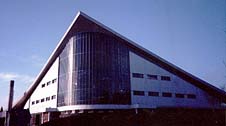
The Wrexham Swimming Baths at Bodhyfryd, completed in May 1970 probably caused more controversy than any other building in the town centre. Instantly recognisable with it's parabolic roof it raised many objections because of the design, cost and difficulty of building. The building housed three pools.
1. The main pool, 33.5 metres in length with two shallow ends at 50cms and a deep centre(210cms).
2. The learners pool, depth ranging from 50cms to 94cms.
3. The diving pool, 12.2 metres square and 3.8 metres deep with a concrete diving stage at 1,3 and 5 metres and spring boards at 1 and 3 metres.
The Wrexham Swimming Baths were closed to the public in 1997 and were officially re-opened by HM The Queen in 1998 after a major refurbishment programme which included removing the diving pool and replacing it with 'Water Rapids' and a 'Water Chute' and re-naming Wrexham Swimming Baths ,'Wrexham Waterworld'.
1. The main pool, 33.5 metres in length with two shallow ends at 50cms and a deep centre(210cms).
2. The learners pool, depth ranging from 50cms to 94cms.
3. The diving pool, 12.2 metres square and 3.8 metres deep with a concrete diving stage at 1,3 and 5 metres and spring boards at 1 and 3 metres.
The Wrexham Swimming Baths were closed to the public in 1997 and were officially re-opened by HM The Queen in 1998 after a major refurbishment programme which included removing the diving pool and replacing it with 'Water Rapids' and a 'Water Chute' and re-naming Wrexham Swimming Baths ,'Wrexham Waterworld'.
The Wynnstay Arms Hotel
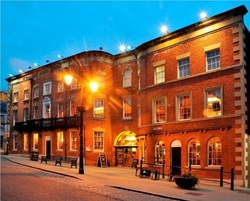
Originally a small inn called The George (recorded in the first quarter of the 18th century) . In 1702 the landlord was listed as John Edwards who was also a smith. By 1723 the inn had been greatly enlarged and the name was changed to The Eagles (or The Three Eagles Spread )when the property was owned by the Williams Wynn family of Wynnstay Hall, Ruabon(the three spread eagles being part of their arms) It is known by this name in 1730 and is referred to as The Eagles as late as 1822, well after the date when it had become commonly known as The Wynnstay Arms.The hotel was a meeting place for 'The Cycle',a pro-Jacobite secret society eastablished with the aim of restoring the house of Stuart to the throne of England.
During the 1960's,the hotel was sold and plans were made for its complete demolition. Pressure was brought to bear on the owners to preserve the building and by way of a compromise, the outer wall, facing High Street was retained while the remainder of the building was demolished and replaced by a modern hotel with a large car park to the rear. The old coaching entrance from Yorke Street was converted into the hotel's main street entrance. At the same time,the hotel's name was changed to the Wrexham Crest Hotel.
In May 1985 the hotel was sold to the Burtonwood Brewery who revived the name The Wynnstay Arms Hotel.
The hotel has been the birthplace of many local organisations including The Cycle, Freemasonary, the Football Association of Wales, the Rotary Club and Round Table.
During the 1960's,the hotel was sold and plans were made for its complete demolition. Pressure was brought to bear on the owners to preserve the building and by way of a compromise, the outer wall, facing High Street was retained while the remainder of the building was demolished and replaced by a modern hotel with a large car park to the rear. The old coaching entrance from Yorke Street was converted into the hotel's main street entrance. At the same time,the hotel's name was changed to the Wrexham Crest Hotel.
In May 1985 the hotel was sold to the Burtonwood Brewery who revived the name The Wynnstay Arms Hotel.
The hotel has been the birthplace of many local organisations including The Cycle, Freemasonary, the Football Association of Wales, the Rotary Club and Round Table.
Erddig Hall
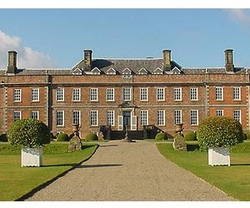
Erddig Hall is a National Trust property on the outskirts of Wrexham.It was built in 1684–1687 for Joshua Edisbury, the high Sheriff of Denbighshire during the reign of James II and was designed by Thomas Webb.
The building was sold to the master of the Chancery, John Mellor in 1714. John Meller refurbished and enlarged the house (including adding the North and South wings in the 1720s), and,on his death in 1733 unmarried and childless, passed it to his nephew, Simon Yorke (d. 1767) (first cousin of Philip Yorke, 1st Earl of Hardwicke). John Mellor's purchases adorn the house to this day; the best can be seen in the Saloon, Tapestry Room and State Bedroom.
The house was passed down through the Yorke family until March 1973, when it was given to the National Trust. This followed the collapse several years earlier of a shaft from the nearby coal mine (Bersham colliery) under the house, causing subsidence of 5 feet (1.5 m), which seriously affected the structural security of the house to the extent that, without suitable underpinning, it would have become a ruin. It was strengthened using the compensation of £120,000 the National Trust was able to extract from the National Coal Board. 63 acres (250,000 m2) of Erddig Park (out of view of the house) was subsequently sold for £995,000 and this paid for the restoration work on the house. The restoration was completed on 27 June 1977 when Charles, Prince of Wales officially opened Erddig to the public, joking that it was the first time in his, albeit short, life that he had opened something that was already 300 years old.
Erddig's walled garden is one of the most important surviving 18th century formal gardens in Britain. The gardens contain rare fruit trees, a canal, a pond, a Victorian era parterre, and are home to an NCCPG National Plant Collection of Hedera (ivy).There is also a fine example of gates and railings made by ironsmiths the Davies brothers, of nearby Bersham, for Stansty Park; the gates were moved to Erddig in 1908. The arrangement of alcoves in the yew hedges in the formal gardens may be a form of bee bole.
The estate buildings include the joiners' shop and smithy (where the joiner and blacksmith worked),the Midden Yard (with its saw mill and cart sheds), and the Stable Yard (with its stables and tack room, carriages and vintage bicycles and vintage cars). The tour of the house begins with the laundry, bakehouse, kitchen and scullery. The nearby river supplied a source of water, and it was pumped uphill by a self running hydraulic ram, which utilised falling water to power itself, and pump the drinking water uphill to the house. Whilst occupied by the Yorke family the house was never installed with mains electricity, with the last Squire, Philip,relying on a portable generator to power his single television set. The saw mill, however, was equipped with its own static steam engine to provide the power for sawing and turning.
The building was sold to the master of the Chancery, John Mellor in 1714. John Meller refurbished and enlarged the house (including adding the North and South wings in the 1720s), and,on his death in 1733 unmarried and childless, passed it to his nephew, Simon Yorke (d. 1767) (first cousin of Philip Yorke, 1st Earl of Hardwicke). John Mellor's purchases adorn the house to this day; the best can be seen in the Saloon, Tapestry Room and State Bedroom.
The house was passed down through the Yorke family until March 1973, when it was given to the National Trust. This followed the collapse several years earlier of a shaft from the nearby coal mine (Bersham colliery) under the house, causing subsidence of 5 feet (1.5 m), which seriously affected the structural security of the house to the extent that, without suitable underpinning, it would have become a ruin. It was strengthened using the compensation of £120,000 the National Trust was able to extract from the National Coal Board. 63 acres (250,000 m2) of Erddig Park (out of view of the house) was subsequently sold for £995,000 and this paid for the restoration work on the house. The restoration was completed on 27 June 1977 when Charles, Prince of Wales officially opened Erddig to the public, joking that it was the first time in his, albeit short, life that he had opened something that was already 300 years old.
Erddig's walled garden is one of the most important surviving 18th century formal gardens in Britain. The gardens contain rare fruit trees, a canal, a pond, a Victorian era parterre, and are home to an NCCPG National Plant Collection of Hedera (ivy).There is also a fine example of gates and railings made by ironsmiths the Davies brothers, of nearby Bersham, for Stansty Park; the gates were moved to Erddig in 1908. The arrangement of alcoves in the yew hedges in the formal gardens may be a form of bee bole.
The estate buildings include the joiners' shop and smithy (where the joiner and blacksmith worked),the Midden Yard (with its saw mill and cart sheds), and the Stable Yard (with its stables and tack room, carriages and vintage bicycles and vintage cars). The tour of the house begins with the laundry, bakehouse, kitchen and scullery. The nearby river supplied a source of water, and it was pumped uphill by a self running hydraulic ram, which utilised falling water to power itself, and pump the drinking water uphill to the house. Whilst occupied by the Yorke family the house was never installed with mains electricity, with the last Squire, Philip,relying on a portable generator to power his single television set. The saw mill, however, was equipped with its own static steam engine to provide the power for sawing and turning.
Wrexham Police Station
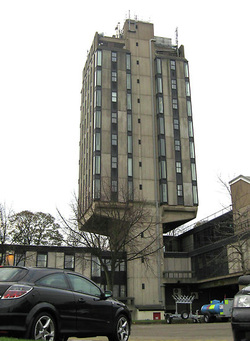
Wrexham Police Station at Bodhyfryd was the Divisional Headquarters of North Wales Police. The 14 storey building was built in the early 1970's to replace the old town centre headquarters (now Wrexham Museum)
At 140ft it is the tallest building in Wrexham and has been described as a 'Monstrosity'. It was demolished on Sunday 1st November 2020 at 8.30am and it's being replaced it with a Lidl supermarket.
At 140ft it is the tallest building in Wrexham and has been described as a 'Monstrosity'. It was demolished on Sunday 1st November 2020 at 8.30am and it's being replaced it with a Lidl supermarket.
Wrexham Museum
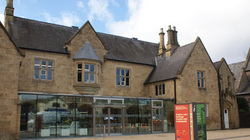
Originally built to a design by local architect Thomas Penson as the Militia. The decision to build new barracks in Hightown in the 1870's made this building redundant and it was converted into the town police station and court buildings. The opening of the new Divisional Police Headquarters at Bodhyfryd
led to the police leaving the building and, the opening of the Law Courts at Bodhyfryd made the building once again redundant.
For about 20 years it was taken over by the Wrexham College of Art and Design until 1995 when it was handed over to Wrexham Council for use as its new Museum.
led to the police leaving the building and, the opening of the Law Courts at Bodhyfryd made the building once again redundant.
For about 20 years it was taken over by the Wrexham College of Art and Design until 1995 when it was handed over to Wrexham Council for use as its new Museum.
Wrexham Lager
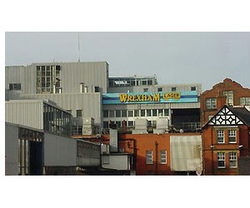
A group of Manchester business men, many of whom were of German origin established the Wrexham Lager Beer Company in 1881, building a specialist brewery in Central Road because of the quality of the Pant Y Golfen spring in Maesgwyn which was very similar to that of the water in Pilsen. They built the brewery in a Bavarian style and the new brewery began production in 1883. Wrexham Lager was actually supplied to the White Star shipping line which greatly expanded the market. Historically, Wrexham Lager was the oldest lager brewery in the UK - its bottles were on the Titanic. There is documentary evidence of the lager appearing in Khartoum as early as 1898.
It closed in 2000 and was mostly demolished between 2002 and 2003. Only the historic building in which brewing started still remains.
In 2002, Martyn Jones, a Member of Parliament for the nearby Clwyd South constituency who had once been employed by the brewery, bought the original name and building for £1 in 2001. Local activists hope that brewing may continue from this building, at least on a small scale. The building itself is listed.
In 2010, local businessman Mark Roberts and his brother Vaughan Roberts expressed an interest in reviving the brand, and met with Ian Dale, who was the brewing manager at the former plant upon closure. They negotiated for the brand from Martyn Jones, although certain rights regarding the old logos remain with Carlsberg-Tetley, precluding their usage. After sourcing the original ingredients used in an older version of the lager and obtaining new brewing equipment from German firm Kaspar Schulz, Wrexham Lager was made available on the 29 October 2011 at the Buck House Hotel in Bangor-on-Dee. Since that time it has been expanded to a range of pubs throughout the country including several pubs within Wrexham itself.
Within two years of the reintroduction, it was reported the new beer had sold 1.3 million pints in 2012, a level assisted by the anniversary of the sinking of the RMS Titanic, which due to the original firm's contract with the White Star Line, resulted in Wrexham Lager being widely believed to have been sold on the ship. As a result of the demand, within the UK and in worldwide markets, the owners have announced an expansion that will increase production tenfold, with the aim of selling 13 million pints within five years. It has also been reported that the firm is in negotiations to have the lager served upon Clive Palmer's replica Titanic II.
It closed in 2000 and was mostly demolished between 2002 and 2003. Only the historic building in which brewing started still remains.
In 2002, Martyn Jones, a Member of Parliament for the nearby Clwyd South constituency who had once been employed by the brewery, bought the original name and building for £1 in 2001. Local activists hope that brewing may continue from this building, at least on a small scale. The building itself is listed.
In 2010, local businessman Mark Roberts and his brother Vaughan Roberts expressed an interest in reviving the brand, and met with Ian Dale, who was the brewing manager at the former plant upon closure. They negotiated for the brand from Martyn Jones, although certain rights regarding the old logos remain with Carlsberg-Tetley, precluding their usage. After sourcing the original ingredients used in an older version of the lager and obtaining new brewing equipment from German firm Kaspar Schulz, Wrexham Lager was made available on the 29 October 2011 at the Buck House Hotel in Bangor-on-Dee. Since that time it has been expanded to a range of pubs throughout the country including several pubs within Wrexham itself.
Within two years of the reintroduction, it was reported the new beer had sold 1.3 million pints in 2012, a level assisted by the anniversary of the sinking of the RMS Titanic, which due to the original firm's contract with the White Star Line, resulted in Wrexham Lager being widely believed to have been sold on the ship. As a result of the demand, within the UK and in worldwide markets, the owners have announced an expansion that will increase production tenfold, with the aim of selling 13 million pints within five years. It has also been reported that the firm is in negotiations to have the lager served upon Clive Palmer's replica Titanic II.
Eagles Meadow
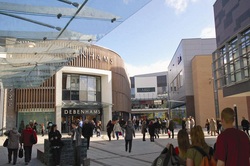
Eagles Meadow takes it's name from being the field behind the 'Eagles Hotel' (now the Wynnstay Arms Hotel) Originally used as stables for local gentry it has now been developed into a major shopping centre. Eagles Meadow was originally lying on lower land than the surrounding area, this has changed with the new development.
In the 1970s the land was divided between a large urban car park and a small retail development which included a new ASDA supermarket. A fly-over bridge was constructed which carried the town's ring road between Smithfield Road and Salop Road. After these developments, the car park was used as the main weekly market in the town, which moved from St George's Crescent (the original 'Beast Market').
The ASDA Store closed in the late 1990s, replaced by a much larger new-build supermarket further down the ring-road in Maesydre. The weekly market moved to a new location at Queens Square.
A number of proposals were put forward for re-development of this land (which is close to St. Giles Church). Firstly John Lewis signed up to anchor a retail based development, which included a number of other stores and a supermarket. This development fell through, and the current landowner and largest stakeholder Wrexham council decided to put the land up for tender with a number of developers.
A large number of tenders were received and in 2003 the winner was chosen as Wilson Bowden in partnership with architects Bernard Engle. The £100m development includes two large department stores, cafes, bars, restaurants and over 40 other stores. It includes a number of landmark buildings and urban plazas, including a 'Spanish Steps' style area. A number of high rise city style apartments were constructed on the town centre side of the development. Construction began in early 2006 and opened to the public on 30 October 2008.
Controversy surrounded the new build, as several shops already located in the town centre moved to Eagles Meadow and closed their shops in the town centre. This has led people to believe that the town centre would become a ghost town.
In the 1970s the land was divided between a large urban car park and a small retail development which included a new ASDA supermarket. A fly-over bridge was constructed which carried the town's ring road between Smithfield Road and Salop Road. After these developments, the car park was used as the main weekly market in the town, which moved from St George's Crescent (the original 'Beast Market').
The ASDA Store closed in the late 1990s, replaced by a much larger new-build supermarket further down the ring-road in Maesydre. The weekly market moved to a new location at Queens Square.
A number of proposals were put forward for re-development of this land (which is close to St. Giles Church). Firstly John Lewis signed up to anchor a retail based development, which included a number of other stores and a supermarket. This development fell through, and the current landowner and largest stakeholder Wrexham council decided to put the land up for tender with a number of developers.
A large number of tenders were received and in 2003 the winner was chosen as Wilson Bowden in partnership with architects Bernard Engle. The £100m development includes two large department stores, cafes, bars, restaurants and over 40 other stores. It includes a number of landmark buildings and urban plazas, including a 'Spanish Steps' style area. A number of high rise city style apartments were constructed on the town centre side of the development. Construction began in early 2006 and opened to the public on 30 October 2008.
Controversy surrounded the new build, as several shops already located in the town centre moved to Eagles Meadow and closed their shops in the town centre. This has led people to believe that the town centre would become a ghost town.
Hightown Barracks
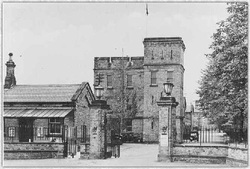
Building work on the barracks to serve as the 23rd Brigade Depot was finished in 1877, having cost £30,000. The first soldiers, members of the 23rd Regiment of foot (R.W.F) moved into the barracks on 17th August 1977. The barracks were the focus of RWF life until the headquarters (along with the museum) were moved to Caernarvon barracks in 1968. During both the First and Second World Wars,recruits reported to Hightown barracks where basic traing was carried out.During the Second World War the barracks were also used by a Commando unit. In recent years the barracks have served as the Depot for the RWF Territorials and the only military presence now is a company of the Royal Welsh Regiment TA.
Island Green
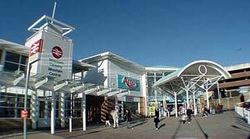
Island Green shopping precinct,car park and railway station was built on the site of the former Central Station and Island Green Brewery.It was developed by Trinity Investments and opened in the summer of 1999. Until the 1998 construction of the Island Green retail park, Wrexham Central station was located 50 metres further along the track.Retailers here include Retail park including retailers such as Argos, Carphone Warehouse, , Poundland, Simon Boyd Home Interiors and Wilkinsons.
Horse and Jockey
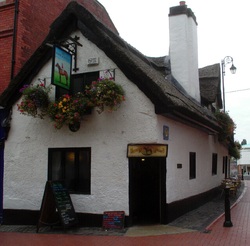
This mainly 17th Century timber framed, thatched roof building occupies a prominent position in Hope Street. Originally a 16th Century hall house, it has long been in use as an inn. It was merged from two premises around 1868; one being a private residence and the other a small beer house named the 'Colliers'. Some surviving elements of timber framing are visible internally.
Town development plans produced in the late 1950's included the demolition of this building but neither they nor a fire in the late 1980's have managed to remove this last example of a timber and thatch building from the Wrexham streetscape.
The Horse and Jockey was named after Fred Archer, 1857-1886, a local champion jockey.
Town development plans produced in the late 1950's included the demolition of this building but neither they nor a fire in the late 1980's have managed to remove this last example of a timber and thatch building from the Wrexham streetscape.
The Horse and Jockey was named after Fred Archer, 1857-1886, a local champion jockey.
Hippodrome Cinema
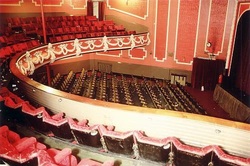
The Wrexham Hippodrome in Henblas Street was built on the site of a former Public Hall which was itself originally built in 1873 and destroyed by fire in 1906.
In 1909 the New Opera House & Public Hall was built on the site and in 1911 this became known as the Wrexham Public Hall, and then later still, the Wrexham Hippodrome.
It had seating for 800 and opened on 2nd August 1909 with the musical comedy Sergeant Brue.
The Cinema closed in November 1959 but was re-opened by Barry Flanagan on the 13th June 1961.
In 1988 ,the cinema was divided into two,following the trend for multi-screen cinemas.
After the opening of a new Odeon multi-screen cinema at Plas Coch in 1997 the Hippodrome closed in the autumn only to re-open for a few weeks over the Christmas period.
In 2004 the Theatre was bought by a property developer and its future became extremely vulnerable. Local campaigners and celebrities, including Ken Dodd fought to save the building for future generations but its redevelopment looked almost certain. Then on the 16th of June 2008 a major fire did extensive damage to the building and its future became even more uncertain. Ironically the fire occurred just a week after the Theatre's former owner Barry Flanagan, who had run the Theatre for over 37 years, passed away.
In 1909 the New Opera House & Public Hall was built on the site and in 1911 this became known as the Wrexham Public Hall, and then later still, the Wrexham Hippodrome.
It had seating for 800 and opened on 2nd August 1909 with the musical comedy Sergeant Brue.
The Cinema closed in November 1959 but was re-opened by Barry Flanagan on the 13th June 1961.
In 1988 ,the cinema was divided into two,following the trend for multi-screen cinemas.
After the opening of a new Odeon multi-screen cinema at Plas Coch in 1997 the Hippodrome closed in the autumn only to re-open for a few weeks over the Christmas period.
In 2004 the Theatre was bought by a property developer and its future became extremely vulnerable. Local campaigners and celebrities, including Ken Dodd fought to save the building for future generations but its redevelopment looked almost certain. Then on the 16th of June 2008 a major fire did extensive damage to the building and its future became even more uncertain. Ironically the fire occurred just a week after the Theatre's former owner Barry Flanagan, who had run the Theatre for over 37 years, passed away.